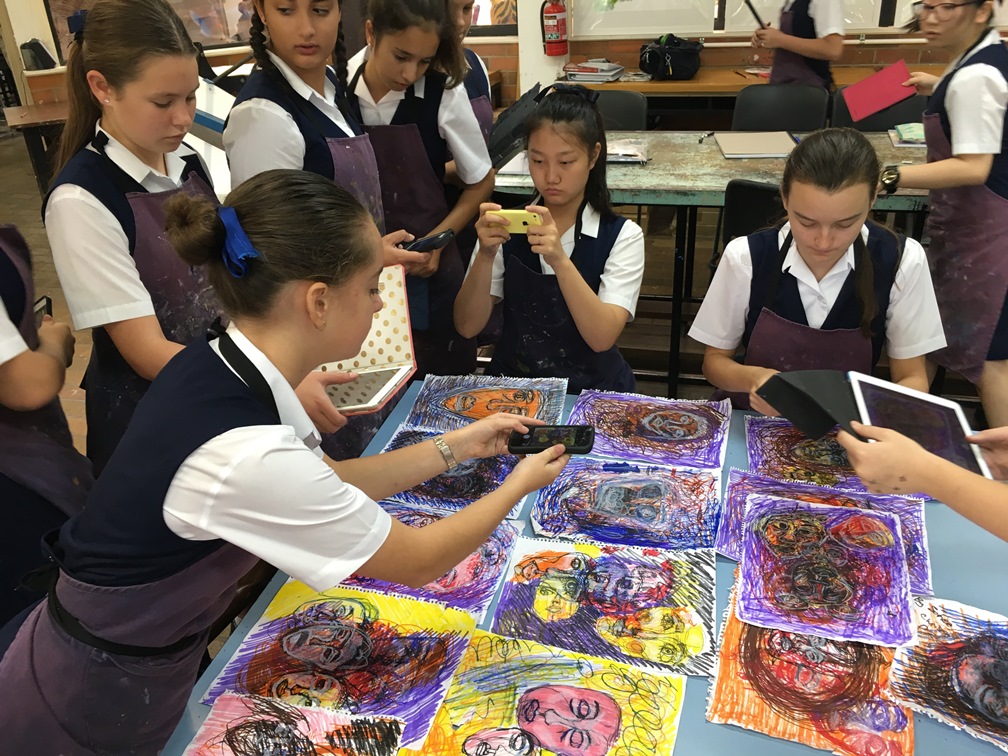
Mixing Paint & Pixels: Considering a ‘Tra-digital’ approach in visual arts
- 5 Sep 2016
By the time our 21st Century children hit secondary school age, it’s almost certainly a personal mobile device that is their most utilised creative tool. Cathy Hunt, educational consultant, author and St Hilda’s School Visual Art teacher, talks about the integration of digital technologies in the visual arts class rooms.
When I think back to my earliest teaching spaces, access to digital technology was very limited. My classes had to move out of the studio and book into ‘computer labs’ to gain access to computers, and those were ‘tethered’, desktop machines. What that meant was that it was generally during research tasks and word-processing written assignments that technology integration occurred, and it rarely permeated our art-making tasks.

From pre-school to higher education, in forward-thinking Visual Arts courses around the world mobile devices now permeate the classroom environment. The ‘tactile and the techy’ can comfortably co-exist in studio spaces where teachers design lessons for a contemporary context. Despite some initial fears about iPads and smart phones amongst mess and materials, it is a curriculum designed to explore hybridity, honour diversity, mash-up and merge, that best reflects a mixed-media approach so familiar to artists, and leverages the non-linear nature of the creative process. Multiple literacies are essential in a developing a culture of innovation, meeting the needs of diverse learners and supporting visual literacy in an increasingly visual world.
Although our students can access a range of media for art-making, it is often the connected camera driving the production of original content, and social media that provides the strongest conduit towards an audience for their work.

Students can develop a rich ‘creative tool-box’ and a flexible, experimental and mixed-media approach that aligns with the needs of the 21st Century learner.
Despite the frequency of their image production, it takes an art teacher just one glance toward the photo library on a student iPad or phone to see that opportunities to explore visual language abound! While photography is often the entry point for creativity on mobile devices, purposeful lesson design can effectively link tactile materials, processes and practices together with digital tools to produce rich learning experiences.
“As we look to design lessons that create seamless technology integration, we try to link tasks to develop rich learning experiences. For example, a project might start with a student creating a drawing in pencil, and then photograph taken of the sketch with the iPad camera follows. The opportunity to digitally manipulate the image using apps results in a new work, and it is saved to the camera roll. Printing the work, adding a wash of colour across the paper and cutting it into pieces sees the creative process continue.”

By engaging with the creative process through these mixed-media workflows, unlimited possibilities can be explored as techniques, processes and media combine. Once the mindset kicks in, paint and pixels merge. For example:
- Creating hand-drawn progressive sketches on paper, photographing those images, and then creating ‘flip-book-style’ animations using a Gif app, sharing them on Instagram.
- Using iPhoneography to capture portraits, importing them into apps for manipulation, then printing and ripping the up the pieces for a collage.
- Capturing the development of a three-dimensional work using time-lapse photography with an iPad as a reflective tool.
For some inspiration for the classroom download Cathy’s e-book for free ipad Art: Lessons, apps and ideas for the ipad in visual arts. The book explores a range of lessons, apps and ideas for teachers, providing practical, hand-on guides and examples of real teaching.
 Cathy is a well-known advocate for the creative integration of technology in education, developing ground-breaking programs for students around the world that combine hands-on, tactile and collaborative ways of working with mobile devices.
Cathy is a well-known advocate for the creative integration of technology in education, developing ground-breaking programs for students around the world that combine hands-on, tactile and collaborative ways of working with mobile devices.
Cathy is an Apple Distinguished Educator currently serving on the Advisory Board for the Asia-Pacific region. Recent accolades include the 2016 International Society of Technology in Education (ISTE) Mobile Learning Innovation Award, two Digital Innovation in Learning Award honourable mentions from Edsurge/Digital Promise and 21st Century Learning International’s Teacher of the Year finalist. Cathy’s iBook, ‘More iPad Art’ also won Best Non-Fiction and Best Reference title at the iBA Awards in Nashville.
As an award-winning educational consultant, presenter, author and experienced Visual Art teacher at The St Hilda’s School on Australia’s the Gold Coast, she has worked with thousands of teachers globally to connect creative technology and cutting-edge pedagogical approaches with diverse learners. Cathy is probably best known for her work on iPadartroom.com, a home base for educators to engage with innovative ideas, resources and technology for learning in that combines paint and pixels.
www.ipadartroom.com
@art_cathyhunt on twitter
Banner image: Using a kaleidoscope app on iPad, students hover their iPad camera over an expressive pencil drawing. The reflections present starting points for new works on canvas. Image courtesy of Cathy Hunt.

